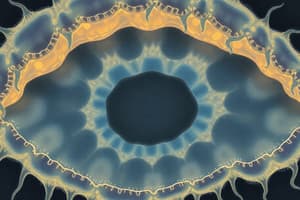Podcast
Questions and Answers
What happens to animal cells and some protists when placed in a hypotonic solution?
What happens to animal cells and some protists when placed in a hypotonic solution?
- They shrink as water enters the cell
- They swell as water enters the cell (correct)
- They rupture as water enters the cell
- They remain unchanged as water enters and exits the cell
How do bacteria, fungi, algae, and plants overcome the problem of water movement?
How do bacteria, fungi, algae, and plants overcome the problem of water movement?
- By actively pumping out excess water using organelles in the cytoplasm
- By remaining unchanged in hypotonic solutions
- By releasing excess water through contractile vacuoles
- By having a rigid cell wall that prevents cells from rupturing (correct)
What is the evolutionary process whereby a population becomes better suited to its habitat?
What is the evolutionary process whereby a population becomes better suited to its habitat?
- Adaptation (correct)
- Homeostasis
- Diffusion
- Osmosis
Which element is a key regulator of water movement and electrical currents in cells?
Which element is a key regulator of water movement and electrical currents in cells?
What is the primary reason for the size limitation of unicellular organisms?
What is the primary reason for the size limitation of unicellular organisms?
Flashcards are hidden until you start studying




